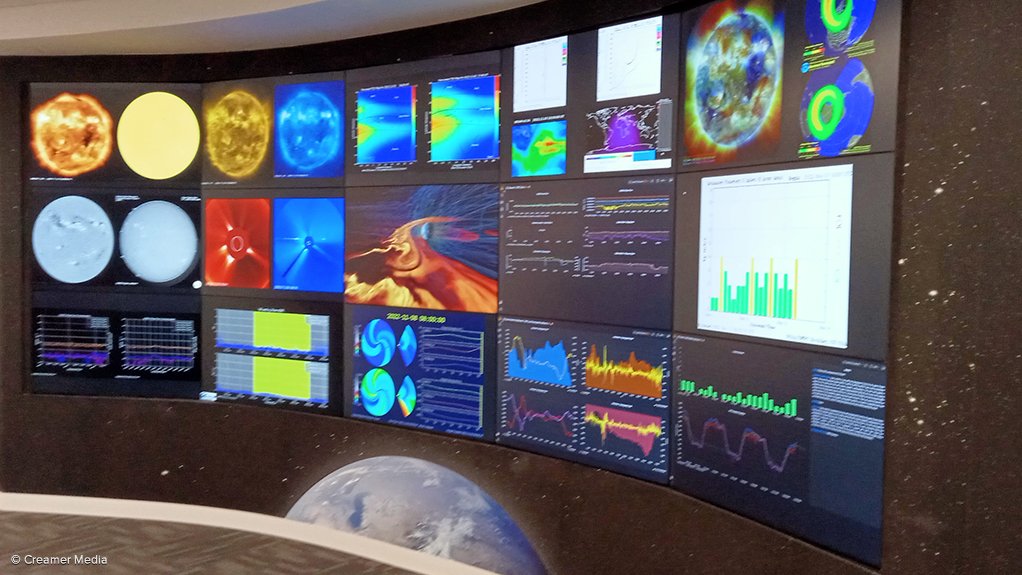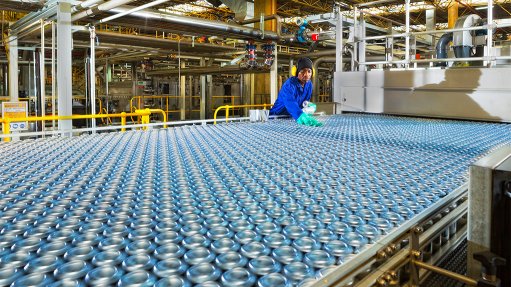Sansa officially inaugurates its 24/7 space weather forecasting capability


A view of the main display in the space weather operations room.
Photo by Creamer Media's Rebecca Campbell
The Space Science division of the South African National Space Agency (Sansa) has officially inaugurated its ‘24/7’ space weather forecasting capability, at its facility in Hermanus (southeast of Cape Town) in the Western Cape province. The inauguration was conducted by South African Higher Education, Science and Innovation Minister Dr Blade Nzimande on Thursday.
In his address, Nzimande reported that the setting up of the capability, which included the construction of a dedicated building and ancillary structures and systems (including a generator to provide power during ‘loadshedding’, when the national electricity utility Eskom implemented rotating power cuts owing to inadequate supply), as well as training staff, had required an investment by Sansa of R107.5-million over three years. He highlighted that Sansa had developed the business case for the ‘24/7’ capability in 2019, and that the programme had been successfully implemented despite taking place during the Covid-19 pandemic.
“Space weather can be defined most basically as the impact solar storms have on Earth’s atmosphere and below,” explains Sansa Space Weather Centre MD Dr Lee-Anne McKinnell. This impact can include damaging satellites in Earth orbit, which could disrupt telecommunications and satellite navigation (‘satnav’ or GPS) services, affect airliners in flight, and even damage power transmission lines. Space weather is a matter of day-to-day practical importance, as well as a fruitful sphere of scientific enquiry.
Sansa Space Science had a limited ability to undertake space weather forecasting for many years, but lacked the capacity (in both personnel and equipment) to do it on a 24/7 basis. But those entities (including airlines, air traffic management agencies, telecommunications companies, and satellite operators) which need such information, need it 24/7. Moreover, they need it on a global basis. Sansa was and is the only agency in Africa with space weather forecasting capability.
Elevating this capability to a 24/7 basis is thus a very important contribution to filling a major ‘gap’ in global coverage and strengthening space weather forecasting worldwide. And Sansa is planning, in partnership with other African countries, including Kenya, Nigeria and Zambia, to close this gap entirely.
“We get our data in near real-time,” she elucidates. “Our data sources are solar observation satellites and a ground-based instrumentation network. This network belongs to Sansa, and is spread across the country, plus the [Gough and Marion] islands and Antarctica. We’re going to expand it, across Africa. As a recognised regional centre we need to be able to forecast for Africa, so we need to bring in data from across the continent. This expansion will be jointly funded by Sansa and our African partners, which include space agencies and universities.”
The ground-based instrumentation network uses three kinds of sensors. The two most common types are magnetometers and satnav receivers. The third, less common, type, is an ionosonde system, which is a ground-based radar system for measuring the ionosphere. In addition, Sansa Space Science has its SuperDARN radar system in the Antarctic. (SuperDARN stands for Super Dual Auroral Radar Network.)
“The SuperDARN radar gives us very important information because it looks up at Earth’s magnetic field lines, giving us a window into ‘geospace’,” she points out. “Geospace is the near-Earth space environment.”
“We normally issue one [space weather forecast] bulletin a day,” reports Sansa space weather researcher Dr (Ms) Rendani Nndanganeni. “But if, for example, a solar flare occurs, we issue a warning as well.” The space weather centre now has eight forecasters and is aiming for 12. There are two shifts, day and night. Day shift requires one forecaster, because she (or he) can be backed up by the division’s space science researchers, but the night shift requires two, to back each other up, as no other scientific support is normally available at night.
Comments
Press Office
Announcements
What's On
Subscribe to improve your user experience...
Option 1 (equivalent of R125 a month):
Receive a weekly copy of Creamer Media's Engineering News & Mining Weekly magazine
(print copy for those in South Africa and e-magazine for those outside of South Africa)
Receive daily email newsletters
Access to full search results
Access archive of magazine back copies
Access to Projects in Progress
Access to ONE Research Report of your choice in PDF format
Option 2 (equivalent of R375 a month):
All benefits from Option 1
PLUS
Access to Creamer Media's Research Channel Africa for ALL Research Reports, in PDF format, on various industrial and mining sectors
including Electricity; Water; Energy Transition; Hydrogen; Roads, Rail and Ports; Coal; Gold; Platinum; Battery Metals; etc.
Already a subscriber?
Forgotten your password?
Receive weekly copy of Creamer Media's Engineering News & Mining Weekly magazine (print copy for those in South Africa and e-magazine for those outside of South Africa)
➕
Recieve daily email newsletters
➕
Access to full search results
➕
Access archive of magazine back copies
➕
Access to Projects in Progress
➕
Access to ONE Research Report of your choice in PDF format
RESEARCH CHANNEL AFRICA
R4500 (equivalent of R375 a month)
SUBSCRIBEAll benefits from Option 1
➕
Access to Creamer Media's Research Channel Africa for ALL Research Reports on various industrial and mining sectors, in PDF format, including on:
Electricity
➕
Water
➕
Energy Transition
➕
Hydrogen
➕
Roads, Rail and Ports
➕
Coal
➕
Gold
➕
Platinum
➕
Battery Metals
➕
etc.
Receive all benefits from Option 1 or Option 2 delivered to numerous people at your company
➕
Multiple User names and Passwords for simultaneous log-ins
➕
Intranet integration access to all in your organisation



















